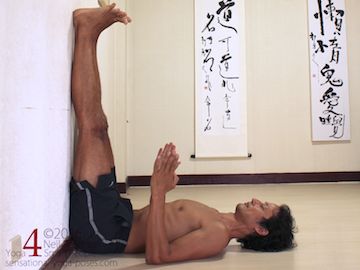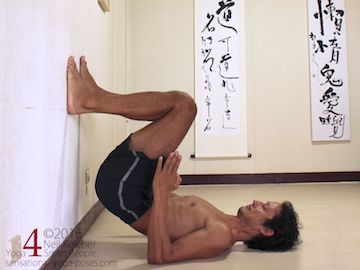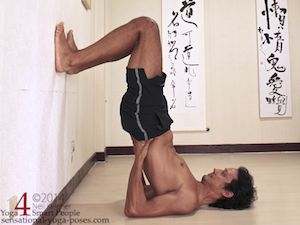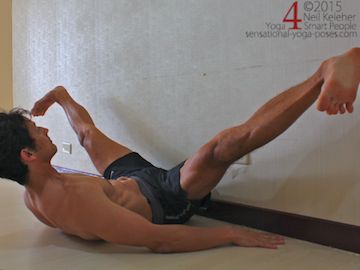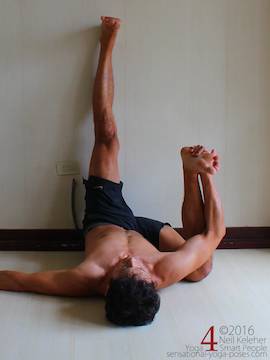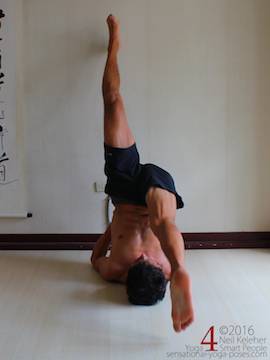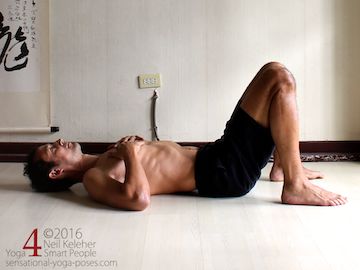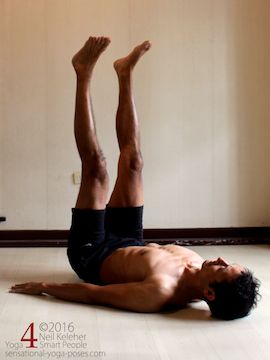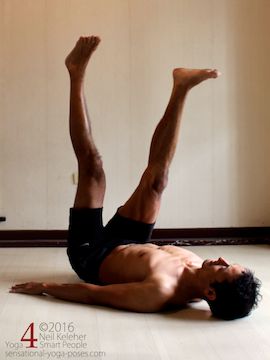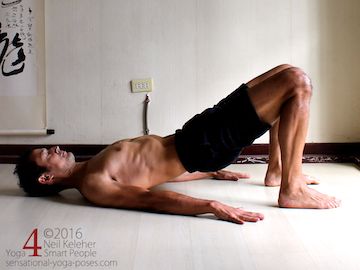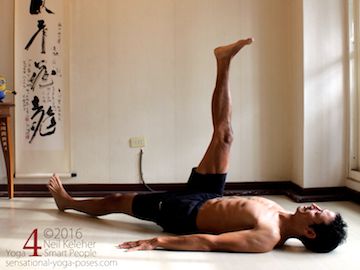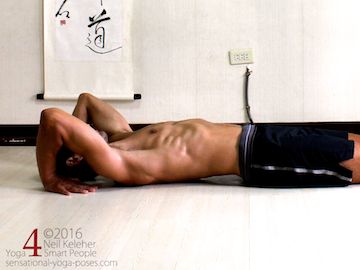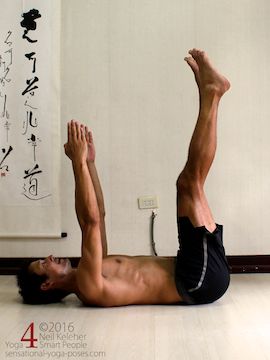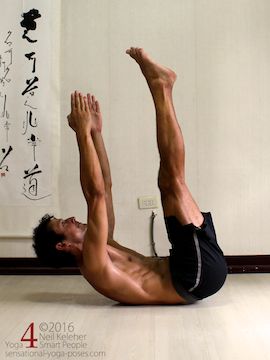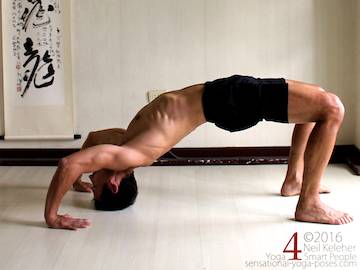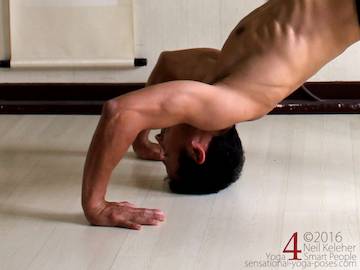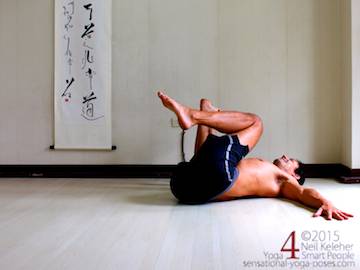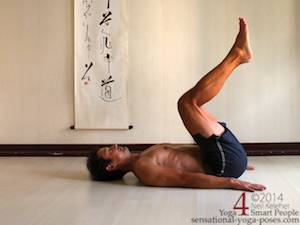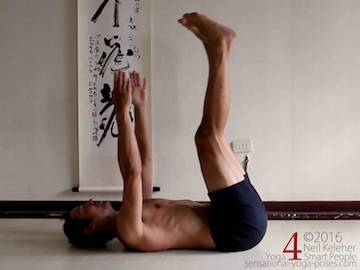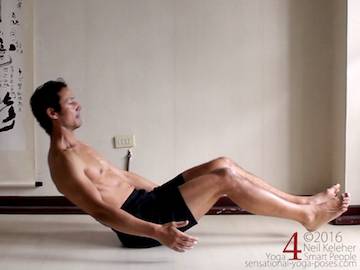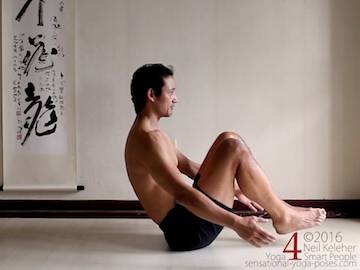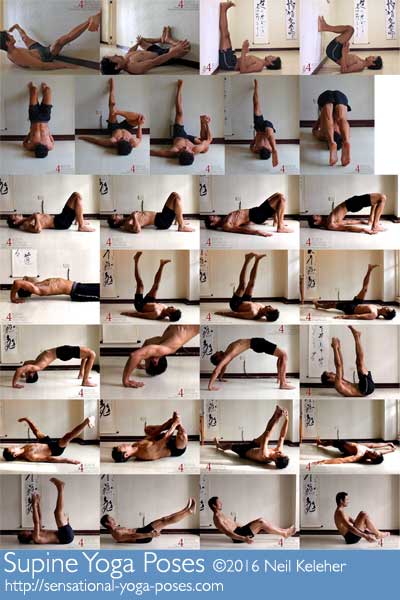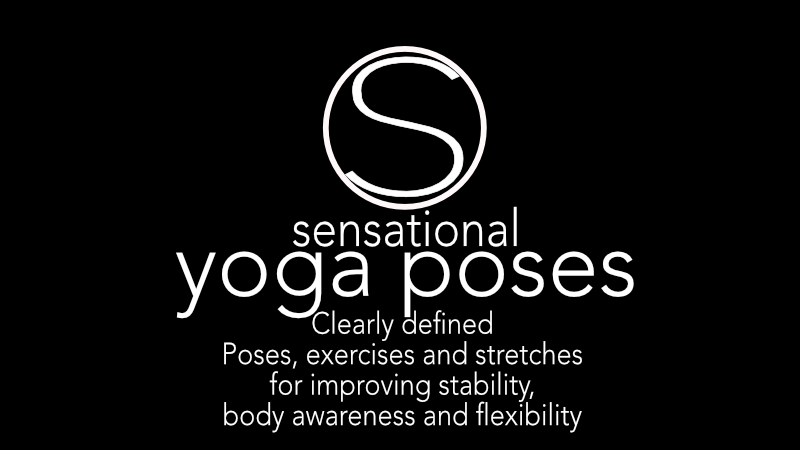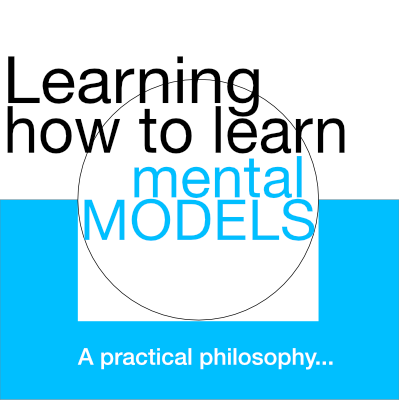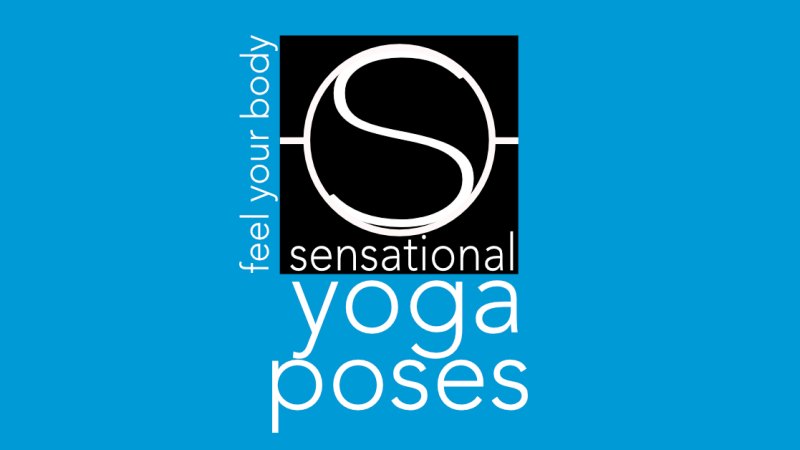Supine Yoga Poses
A mixed level sequence of reclining yoga poses
On page cat links
Bound angle, Bound angle supine, Bridge pose, Dead dog, Foot behind the head, Hamstring stretch, Happy baby, Hip extensor stretch, Hip flexion, Plough pose, Reverse push up, Side splits, Wheel pose
Supine yoga poses (poses where the belly faces upwards) can be used to strengthen the back of the body and the front.
Some supine poses can be done using a wall, very handy if you are tired or are flexibility impaired.
They can also be done without a wall.
The following supine yoga poses have been arranged so that you can do them as a sequence of yoga poses. Skip the poses that you aren't ready for.
Supine Poses Index
Quick links
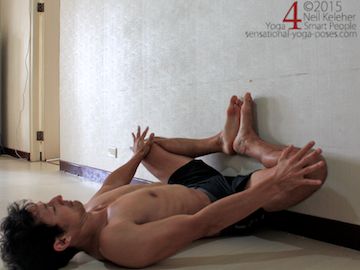
Feet on wall bound angle
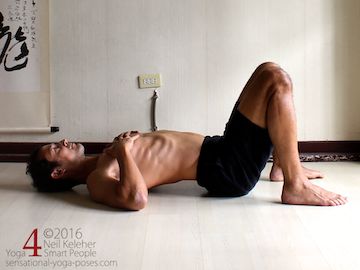
Supine lumbar extension
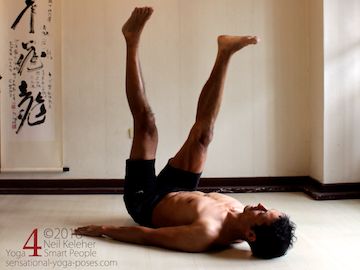
Supine hip flexion 1
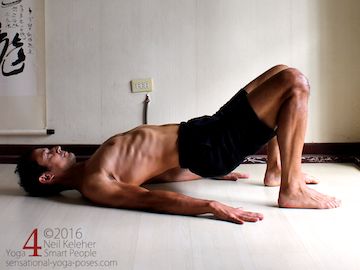
Supine lumbar extension 2
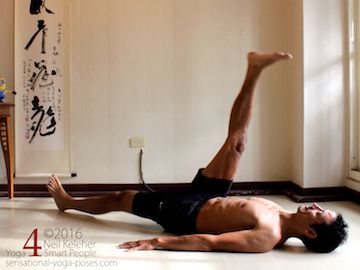
Supine hip flexion 2
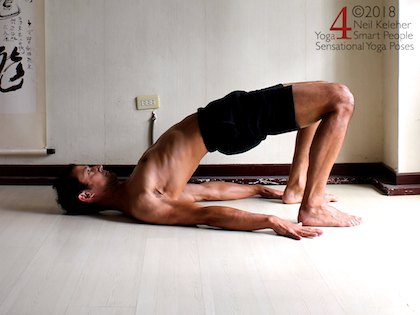
Supine lumbar extension 3
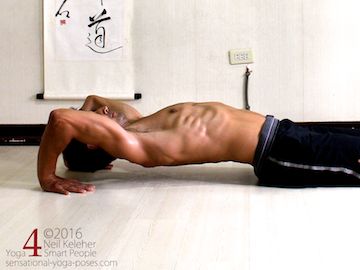
Reverse push up
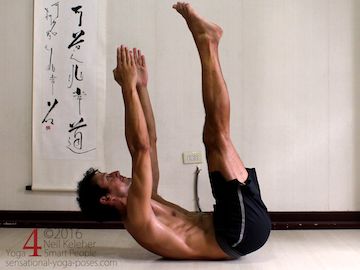
Dead dog reach
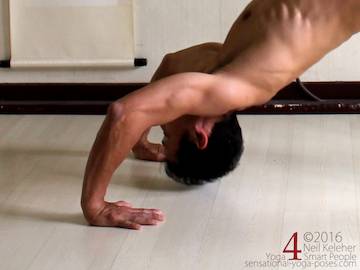
Crown reverse push up
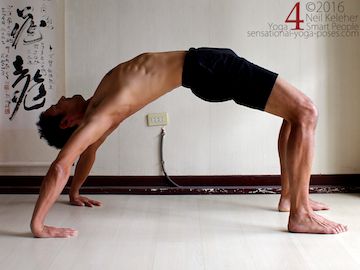
Wheel pose
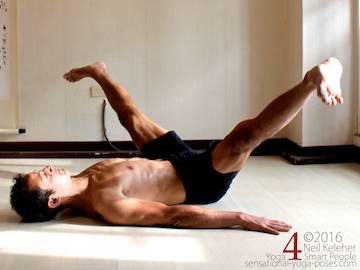
Supine side splits
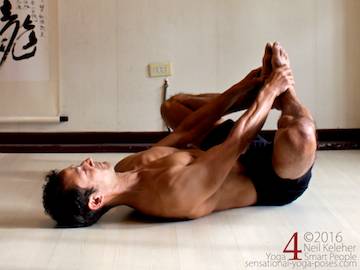
Supine bound angle foot grab
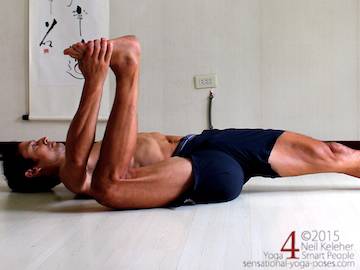
Happy baby pose
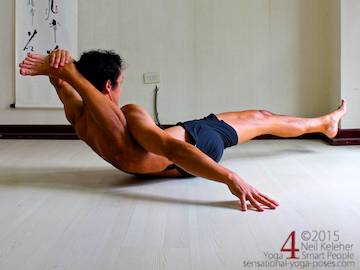
Foot behind the head pose
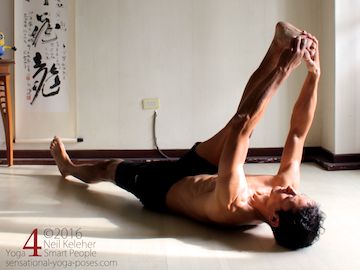
Supine hamstring stretch 1
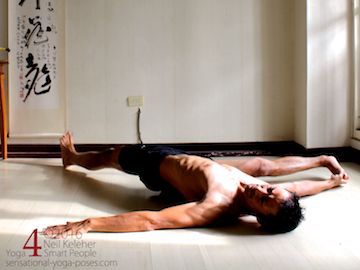
Supine hamstring stretch 2
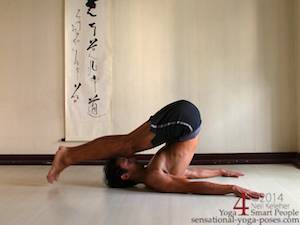
Rolling into plough pose
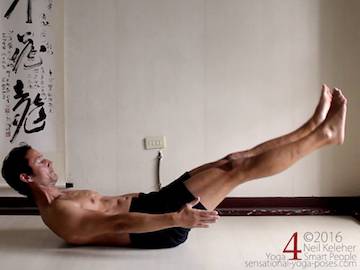
Rolling sit up
A very simple supine exercise with feet against the wall is to press your heels against the wall. This can progress to bending your knees and then using your feet to lift your hips.
A pair of poses you can do while supine is side splits followed by bound angle.
For happy baby (one leg at a time) try to draw one knee to the floor beside your ribcage. Doing splits with one heel against a wall and the other reaching past your head, focus on making both legs active. Press the heel against the wall. Pull the other foot down into the floor. (Use yoga blocks or a chair if you can't yet reach the floor.)
Supine Poses Away from the Wall
This exercise is a warm up for bridge pose. Practice arching your lumbar spine and thoracic spine off of the floor. To do so focus on pulling your tailbone towards your shoulders. Or focus on pushing your pubic bone away from your chest.
With both legs lifted, focus on pulling one leg back without lifting the hip. Relax and then switch. Repeat about five times per leg. Work at slowly contracting and slowly releasing.
Next repeat the lumbar/thoracic extension exercise but with hips lifted. Here again focus on moving your pubic bone or tailbone so that your pelvis tilts forwards and your lumbar spine arches rearwards.
For this exercise lift one leg and leave the other leg on the floor but with knee pointing upwards. First pull the lifted leg rearwards. Keep it active and then push down into the floor with the other leg. Relax, switch legs and repeat, 5 times for each leg.
For bridge pose focus on using your legs to push your pelvis upwards. Bend your lumbar spine and thoracic spine backwards. As you do so you can shuffle your shoulders closer to your feet. You can also focus on opening your chest. As you open your chest press your shoulders down into the floor.
With hands beside your head focus on pressing your hands down into the floor. Lift your ribcage. Lower and then repeat.
First lie supine with arms and legs reaching up. This can be a pose in it's own right, a relaxing one.
Keeping arms and legs reaching upwards, lift your pelvis and then your upper back. Hold this lifted position (dead dog reach) for a few breaths.
Then lower your pelvis and ribcage, followed by your arms and legs.
If you find it too difficult to lift your pelvis and ribcage, or keep them lifted, try holding your ankles with your hands while exhaling then release your hands while inhaling.
For this set of exercises lift your hips and then press up on to the crown of your head. Press down with your hands, slowly lift your head an inch off of the floor. Lower, then relax. Repeat three or more times then rest. Repeat one or two times after resting.
If you are able to lift your head off of the floor in the previous exercise, work at straightening your elbows. Work at pressing all the way up, pause, lower and then repeat. Then work towards holding wheel pose. Gradually increase hold time either counting seconds or breaths.
While supine reach both legs out to the sides. Work at pulling your feet towards your face.
With knees bent place your feet together and hold on with both hands. Pull back on your feet with your hands. Push into your hands with your feet and push your knees forwards also. You could also do this one leg at a time first, preventing the foot from crossing your center line.
For happy baby grab one foot and pull the knee to the floor beside your ribcage. Start with other knee bent and then after pulling knee down reach the other leg forwards and work at touching the heel to the floor.
Happy baby pose can be used as part of a warm up for foot behind the head. Note that you can think of this as a binding yoga pose. You can use your back muscles against your leg muscles in this challenging yoga pose.
Lift a leg and Grab the shin, ankle or foot. Keeping your back on the floor pull the thigh towards your chest. Hold for five or so breaths and then reach the leg to the side.
Leave this out if you have neck problems.
These can be used as a preparation for both plow pose and shoulder stand.
Laying on your back with legs up (and hands forwards) reach your legs back and lift your hips. Try to balance on your upper back.
Use your hands to help initially. Lower and repeat. Then try it with your hands reaching past your head (not shown.) Work at a slow and controlled lifting and lowering action.
Lying supine with legs (and arms) reaching up, reach legs and arms forwards (hold on to your thighs if you need to) and sit up, balancing on your butt without touching feet to the floor. Slowly lay back down, lifting legs and arms and resting head on the floor. Then repeat three or more times. If you have to use your hands to help, work at gradually relaxing your arms to the point that you can do this action without using them to help.
What Next?
If you started with these poses, you could roll to sitting and do seated yoga poses. Or stand up for standing yoga poses.
You could also finish here.
Published: 2016 01 09
Updated: 2021 01 24


















